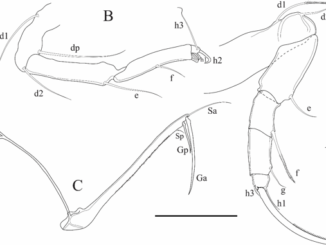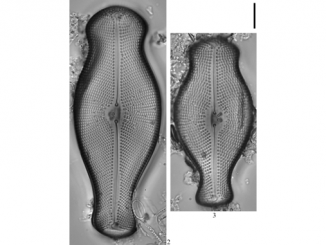
Paper category: Original research paper
Corresponding author: Waldemar Surosz (waldemar.surosz@ug.edu.pl)
DOI: 10.1515/ohs-2018-0007
Received: 19 July 2017
Accepted: 25 September 2017
Full text: here
Citation (APA style):
Abstract
We present the first report and description of the pinnate diatom Haslea sp. from the northeastern Adriatic Sea, Croatia, producing a blue pigment. This organism is very similar to the well-known Haslea ostrearia, the first described “blue” diatom producing marennine, i.e. the pigment involved in the greening of oysters, and recently described H. provincialis. However, the Croatian diatom slightly differs from other Haslea species in its morphology and 18S rRNA sequence. The discovery of Haslea sp. from Croatia confirmed the possible existence of more species among the representatives of blue Haslea species, as previously assumed. The discovery of several genetically distinct populations of Haslea ostrearia, new species H. karadagensis, H. provincialis and Haslea sp. from Croatia, suggests that species richness in the group of “blue” diatoms is probably underestimated and still more new blue diatoms remain undiscovered. This also raises questions about previously published reports and observations of Haslea distribution in the Mediterranean Sea whether these organisms really belong to H. ostrearia.
References
Abed, R.M.M., Palinska, K.A., Camoin, G. & Golubic, S. (2006). Common evolutionary origin of planktonic and benthic nitrogen fixing oscillatoriacean cyanobacteria from tropical oceans. FEMS Microbiology Letters 260: 171–177. DOI: 10.1111/j.1574-6968.2006.00321.x.
Barone, R. (1979). La diatomee bentoniche del porto di Palermo. Giornale Botanica Italiano 3: 187–295.
Briée, C. (2010). Le verdissement des huîtres: deux siècles de transformation d’un problème biologique. Unpublished doctoral dissertation. University of Nantes.
Dyer, W.T.T. (1877). Greening of oysters. Nature 16: 397.
Funk, G. (1919). Notizen über Meeresdiatomeen. Berichte der Deutschen Botanischen Gesellschaft 37: 187–192.
Gaillon, B. (1820). Des huîtres vertes, et des causes de cette coloration. Journal de physique, de chimie, d’histoire naturelle et des arts 91: 222–225.
Gastineau, R., Davidovich, N.A., Bardeau. J-F., Caruso, A., Leignel, V. et al. (2012). Haslea karadagensis (Bacillariophyta): a second blue diatom, recorded from the Black Sea and producing a novel blue pigment. European Journal of Phycology 47: 469–479. DOI: 10.1080/09670262.2012.741713.
Gastineau, R., Davidovich, N.A., Hansen, G., Rines, J., Wulff, A. et al. (2014). Haslea ostrearia like diatoms: biodiversity out of the blue. Advances in Botanical Research 71: 441–446. DOI: 10.1016/B978-0-12-408062-1.00015-9.
Gastineau, R., Hansen, G., Davidovich, N.A., Davidovich, O., Bardeau, J-F. et al. (2016). A new blue-pigmented hasleoid diatom, Haslea provincialis, from the Mediterranean Sea. European Journal of Phycology 51: 156–170. DOI: 10.1080/09670262.2015.1110861.
Gastineau, R., Leignel, V., Jacquette, B., Bendahmane, D., Hardivillier, Y. et al. (2013). Inheritance of mitochondrial DNA in the pennate diatom Haslea ostrearia (Naviculaceae) during auxosporulation suggests a uniparental transmission. Protist 164: 340–351. DOI: 10.1016/j.protis.2013.01.001.
Grunow, A. (1877). New diatoms from Honduras. Monthly Microscopical Journal 18: 165–186.
Hardy, J.T. (1973). Ecology of phytoneuston in a temperate marine lagoon. Limnology and Oceanography 18: 525–533. DOI: 10.4319/lo.1973.18.4.0525.
Hendey, N.I. (1964). An Introductory Account of the Smaller Algae of British Coastal Waters Part V: Bacillariophyceae (Diatoms). HMSO London.
Höfler, K., Url, W. & Diskus, A. (1956). Zellphysiologie Beobachtungen und Versuche an Algen der Lagune von Venedig. Bollettino del Museo civico di Storia Naturale di Venezia 9: 63–94.
Hustedt, F. & Aleem, A.A. (1951). Littoral diatoms from the Salstone near Plymouth. Journal of Marine Biology Association UK 30: 177–196. DOI: 10.1017/S0025315400012662.
Kennett, D.M. & Hargraves, P.E. (1991). Benthic marine diatoms. In R.G. Sheath & M.M. Harlin (Eds.), Freshwater and Marine Plants of Rhode Island (pp. 127–135). Kendall and Hunt Publishing Company, Dubuque.
M’harzi, A., Tackx, M., Daro, M.H., Kesaulia, I., Caturao, R. et al. (1998). Winter distribution of phytoplankton and zooplankton around some sandbanks of the Belgian coastal zone. Journal of Plankton Research 20: 2031–2052. DOI: 10.1093/plankt/20.11.2031.
Molisch, H. (1903). Notiz űber eine blaue Diatomee. Berichte der Deutschen Botanischen Gesellschaft 21: 23–26.
Palinska, K.A., Thomasius, C.F., Marquardt, J. & Golubic, S. (2006). Phylogenetic evaluation of cyanobacteria preserved as historic herbarium exsiccata. International Journal of Systematic and Evolutionary Microbiology 56: 2253-2263. DOI: 10.1099/ijs.0.64417-0.
Pillet, L., de Vargas, C. & Pawlowski, J. (2011). Molecular identification of sequestered diatom chloroplasts and kleptoplastidy in foraminifera. Protist 162: 394–404. DOI: 10.1016/j.protis.2010.10.001.
Ranson, G. (1937) Le verdissement des huîtres. Sciences 8: 13–24.
Sauvageau, C. (1906). A propos de la présence de la diatomée bleue dans la Méditerranée. Travaux des laboratories (Arcachon) 6: 46–59.
Simonsen, R. (1974). The diatom plankton of the Indian Ocean expedition of RV ‘Meteor. Forschungsergebnisse, Reihe D 19: 46–49.
Snoeijs, P. & Kasperoviciene, J. (1996). Intercalibration and distribution of diatom species in the Baltic Sea. Volume 4. Uppsala: Opulus Press.
Solazzi, A. & Tolomio, C. (1976). Il fitoplancton primaverile ed estivo lungo le coste settentrionali della Sardegna. Archivio de Oceanografia e Limnologia 18: 389–409.
Solazzi, A., Tolomio, C., Andreoli, C., Caniglia, G. & Colliva, V. (1972). La Laguna di Lesina (Foggia). Carico microfitico in un ciclo annuale. Memorie di Biogeografica Adriatica 9: 1–42.
Sprat, T. (1667). The history of the generation and ordering of green Oysters, commonly called Colchester Oysters. History of the Royal Society (pp. 307–319), London.
Tolomio, C. (1976) Variazioni stagionali e stazionali del firoplancton nella Laguna di Marano (Udine). Pubblicazioni della Stazione Zoologica di Napoli 40: 133–237.
Tolomio, C. (1978). Catalogo delle Diatomee e delle Peridinee pin signifactive segnalate nelle acque salmastre italiane. Memorie di Biologia Marina e di Oceanagrafia 8: 129–150.
Tolomio, C. (1982). Ricerche sul fitoplancton e su alcuni fattori ambientali nella laguna di grado (Gorizia). Rivista di Idrobiologia 21: 75–96.
Tolomio, C. (1984). Osservazioni a breve termine sulla microflora pelagica estiva in due stazioni costiere nel Tirreno Settentrionale. Quaderni del Museo di Storia Naturale di Livorno 5: 61–68.
Tolomio, C. (1988). Il fitoplancton della valle di brenta (laguna veneta). Indagini stagionali: giugno 1980 – marzo 1982. Archivio di Oceanografia e Limnologia 21: 117–150.
Tolomio, C. & Bullo, L. (2001a). Influenza delle maree di sizigie e di quadratura sulle comunità fitoplanctoniche del bacino di chioggia. Lavori Società Veneziana di Scienze Naturali 26: 53–69.
Tolomio, C. & Bullo, L. (2001b). Prelievi giornalieri di fitoplancton in una stazione del bacino meridionale della Laguna di Venezia. Bollettino del Museo Civico di Storia Naturale di Venezia 52: 1–23.
Volkman, J.K., Barrett, S.M. & Dunstan, G.A. (1994). C25 and C30 highly branched isoprenoid alkenes in laboratory cultures of two marine diatoms. Organic Geochemistry 21: 407–414. DOI: 10.1016/0146-6380(94)90202-X.
Whittaker, K.A., Rignanese, D.R., Olson, R.J. & Rynearson, T.A. (2012). Molecular subdivision of the marine diatom Thalassiosira rotula in relation to geographic distribution, genome size, and physiology. BMC Evolutionary Biology 12: 209. DOI: 10.1186/1471-2148-12-209.
Wulff, A., Wängberg, S.A., Sundbäck, K., Nilsson, C. & Underwood, G.J.C. (2000). Effects of UVB radiation on a marine microphytobenthic community growing on a sand substratum under different nutrient conditions. Limnology and Oceanography 45: 1144–1152. DOI: 10.4319/lo.2000.45.5.1144.
Zimmermann, J., Jahn, R. & Gemeinholzer, B. (2011). Barcoding diatoms: evaluation of the V4 subregion on the 18S rRNA gene, including new primers and protocols. Organisms, Diversity and Evolution 11: 173–192. DOI: 10.1007/s13127-011-0050-6.




Bądź pierwszy, który skomentuje ten wpis